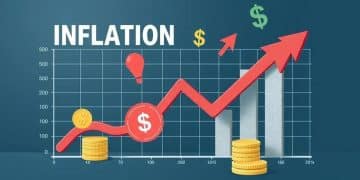Head interest rate outlook: what to expect in 2024

The head interest rate outlook for 2024 indicates that rising rates are primarily influenced by inflation, economic growth, and global market conditions, significantly impacting mortgage costs and borrowing strategies.
The head interest rate outlook for 2024 is raising eyebrows across the financial landscape. Are you curious about how these shifts could affect your investments or loans? Let’s dive into what lies ahead.
Understanding current head interest rates
Understanding the current head interest rates is crucial for making informed financial decisions. With fluctuations in the economy, keeping track of these rates can help you better prepare for upcoming changes.
What Are Head Interest Rates?
Head interest rates refer to the benchmark rates that influence various lending and investment rates across the market. These rates are set by central banks and have a direct impact on loan interest rates, mortgage rates, and even savings account rates.
Key Factors Influencing Current Rates
Several elements contribute to the determination of head interest rates:
- Inflation levels
- Economic growth data
- Unemployment rates
- Global economic trends and events
For instance, when inflation rises, central banks might raise interest rates to stabilize the economy. Conversely, in a struggling economy, rates may be lowered to encourage borrowing and investing.
The current head interest rates are affected by global markets and policy decisions. Monitoring these developments is essential, especially for homeowners and investors. For instance, if you’re considering buying a home, knowing the rate trajectory can significantly impact your financial strategy.
Implications for Borrowing
Understanding these rates can aid in predicting future borrowing costs. As rates rise, loans can become more expensive, affecting both consumers and businesses. Conversely, lower rates can stimulate borrowing and economic activity, allowing individuals to purchase homes or finance projects.
In summary, keeping an eye on the current head interest rates is vital for anyone planning to make significant financial moves. By understanding these rates, you can navigate the lending landscape more effectively and make decisions that align with your financial goals.
Factors influencing future interest rates
Several factors are pivotal in influencing future interest rates. Understanding these can help individuals and businesses anticipate financial changes and prepare accordingly. Key elements include economic indicators, government policies, and global events that impact market sentiments.
Economic Indicators
Economic indicators play a crucial role in shaping future interest rates. These include inflation rates, GDP growth, and employment data. For example, if inflation rises above target levels, central banks may respond by increasing rates to cool down the economy.
Government Policies
Government monetary policies substantially influence interest rates. When a central bank, like the Federal Reserve in the U.S., adjusts its policy stance, it sends signals to the market. During economic downturns, central banks often lower interest rates to encourage spending and investment.
- Lower rates can spur economic growth.
- Higher rates can control inflation.
- Policy changes are typically based on extensive economic analyses.
These decisions impact not only borrowing costs for consumers but also affect business investments and overall economic activity.
Global Influences
Global economic events also shape the landscape for interest rates. Trade agreements, geopolitical tensions, and international market trends can cause fluctuations. For instance, uncertainty in global markets may lead to a flight to safety, influencing the demand for bonds, which in turn affects interest rates.
In summary, understanding the key factors that determine future interest rates—such as economic indicators, government actions, and global influences—empowers individuals to better navigate their financial choices.
Impact of interest rates on mortgages

The impact of interest rates on mortgages is significant and can change the way people buy homes. When rates rise, borrowing becomes more expensive, which can deter potential buyers. Conversely, lower rates often motivate more people to purchase homes, making mortgages more accessible.
How Interest Rates Affect Monthly Payments
When interest rates increase, the monthly payments on mortgages also rise. This can affect how much home buyers can afford. For instance, a small increase in interest rates can lead to higher payments, which may push some buyers out of the market. Understanding this relationship is crucial for anyone considering purchasing a home.
Long-Term Financial Implications
The long-term effects of interest rates on mortgages can also be significant. A higher interest rate means you pay more over the life of the loan, which can add up to thousands of dollars. On the other hand, locking in a lower rate can save homeowners a considerable amount over time.
- Higher rates increase total loan costs.
- Lower rates can lead to more significant savings.
- Changing rates can affect refinancing options.
This knowledge can help buyers make informed decisions when entering the housing market. Understanding how interest rates influence purchasing power and long-term costs empowers homebuyers to plan effectively.
Current Trends in Interest Rates
Keeping an eye on current interest rates is essential for potential homebuyers. Trends can shift rapidly, and being aware of these movements can help buyers time their purchases better. Additionally, buyers should also consider how these rates interact with other factors like the economy and local housing markets.
Overall, the impact of interest rates on mortgages plays a critical role in the housing market. By understanding this relationship, you can make smarter, more informed decisions when buying a home.
How to prepare for rising interest rates
Preparing for rising interest rates is essential for anyone looking to manage their finances effectively. As rates climb, the cost of borrowing can increase, impacting loans and mortgages. Knowing how to adjust your financial strategies is crucial for maintaining financial health.
Assess Your Current Financial Situation
The first step in preparation is to assess your current financial situation. Take a close look at your income, expenses, and existing debts. Understanding where you stand financially will help you make informed decisions as rates begin to rise.
Consider Fixed-Rate Loans
If you have variable-rate loans, consider switching to fixed-rate loans. This change can lock in lower rates before they increase further. It provides loan stability, ensuring predictable payments over time. Here are some key benefits:
- Predictable monthly payments
- Protection against future rate increases
- Budgeting becomes easier with fixed payments
Transitioning to fixed-rate loans can be particularly beneficial if you expect significant increases in interest rates.
Build an Emergency Fund
Having an emergency fund can help cushion the financial blow from rising interest rates. This fund should cover 3 to 6 months of living expenses. It provides a safety net if unexpected costs arise and helps you avoid higher-interest debt.
As interest rates rise, it’s also advisable to consider refinancing options. Look for opportunities to refinance existing loans before rates climb too high. This can lead to substantial savings over the life of the loan.
Stay Informed About Market Trends
Keeping an eye on market trends is essential. Being aware of predicted changes in interest rates allows you to adjust your financial plans proactively. Subscribe to financial news or set alerts for changes in interest rates to stay ahead.
By preparing for rising interest rates, you can navigate financial changes effectively, ensuring your finances remain stable and manageable.
Expert predictions for 2024 interest trends
Expert predictions for 2024 interest trends are essential for anyone planning major financial decisions. Analysts closely monitor economic indicators and central bank policies to forecast how rates might change. Based on these analyses, it appears that interest rates will continue to fluctuate as the economy responds to various pressures.
Economic Recovery and Inflation
As the economy recovers, inflation remains a critical factor influencing interest rates. Many experts believe that if inflation persists, central banks may decide to raise rates to combat it. This action often aims to stabilize prices and ensure sustainable growth.
Global Economic Conditions
Another element affecting interest trends is global economic conditions. Events such as geopolitical tensions or shifts in trade policies can impact investors’ confidence, influencing interest rates. For instance, if global markets show signs of instability, central banks might adjust rates in response.
- Increased rates may be used to curb inflation.
- Global events affect domestic investment sentiment.
- Economic growth can lead to higher borrowing costs.
Experts suggest keeping an eye on these global factors, as they may significantly shape the interest rate environment in 2024.
Technological Advancements and Market Adjustments
Technological advancements also influence interest rates. As technology improves efficiency in various sectors, growth can occur without an accompanying rise in inflation. Some analysts argue that this can keep interest rates lower than expected, despite the pressure from improving economic conditions.
In summary, forecasts for 2024 interest trends suggest that the interplay of economic recovery, inflation, and global conditions will be crucial. Observing these factors can help individuals and businesses make informed financial choices as the year progresses.
In conclusion, understanding the dynamics of interest rates is vital for making sound financial decisions. As we look ahead to 2024, key factors such as inflation, economic growth, and global events will significantly influence interest trends. By staying informed and being prepared, individuals and businesses can better navigate the challenges of a changing financial landscape. Adopting strategies now can lead to better outcomes in the future, ensuring that you make the most of your financial resources.
FAQ – Frequently Asked Questions about Interest Rates
What are the main factors influencing interest rates?
The main factors include inflation, economic growth, government policies, and global economic conditions.
How do rising interest rates affect mortgages?
Rising interest rates generally lead to higher monthly payments on mortgages, making borrowing more expensive for homebuyers.
What strategies can help prepare for rising interest rates?
Consider refinancing to fixed-rate loans, building an emergency fund, and staying informed about market trends.
Why is it important to monitor interest rate trends?
Monitoring interest rate trends helps individuals and businesses make informed financial decisions and planning adjustments.





